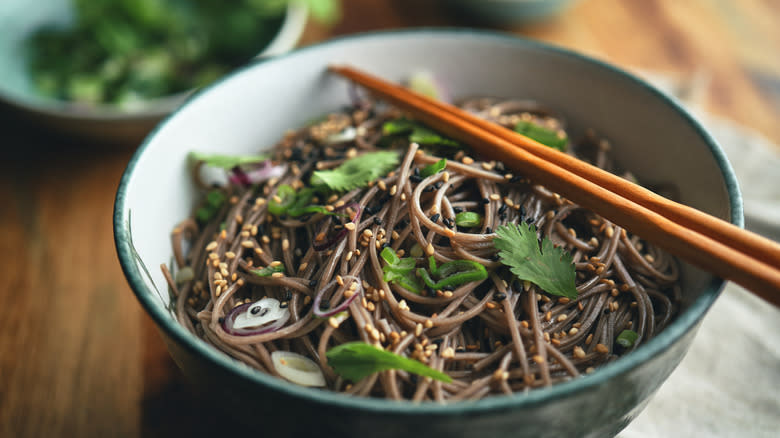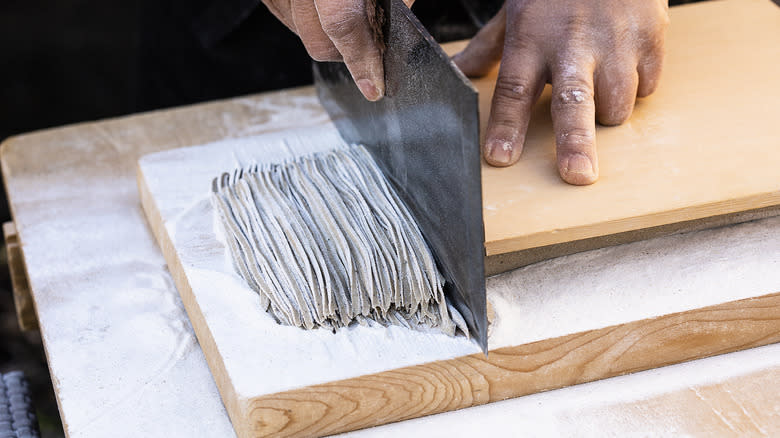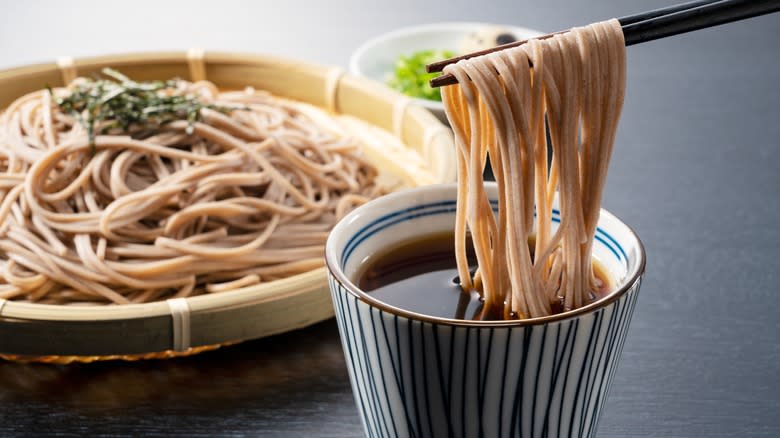Why It's A Total Mistake To Make Soba Noodles From Scratch

Many foods taste better when you make them from scratch. They're more fresh, more flavorful, often more healthy. Certainly the act of cooking is more laborious than opening a can or tearing into a package, but the result is worth the time and effort -- most of the time. Namiko Hirasawa Chen (otherwise known at Nami), the creator behind the Japanese recipe blog Just One Cookbook, has at least one dish that she says shouldn't get the scratch treatment. Nami maintains that soba noodles are best left to the professionals.
Soba are Japanese noodles made from buckwheat flour. Buckwheat, which is not actually a wheat but a type of seed usually referred to as "pseudo-grain," gives the noodles a light brown color and nutty flavor. Traditionally, the ingredients for soba only include buckwheat flour and water -- but that recipe is deceptively simple.
"Making soba is a specialty in Japan," Nami told Daily Meal, "and artisans train extensively to master the craft." In addition to the years of experience soba artisans receive, many also rely on special equipment. So if you only have an afternoon to devote to noodle-making, and not a career, then soba is best left alone or purchased from the professionals. Because buckwheat will be your culinary stumbling block.
Read more: 5 Rice Brands To Buy, And 5 To Avoid
The Pseudo-Grain That Makes Soba So Finicky

It's buckwheat that makes soba noodles so difficult to master. Gluten is a structural protein found in wheat, rye, barley, and triticale that acts as a sticky binding agent and lends a form to bread, pastas, and other gluten-filled dishes. However, buckwheat contains no gluten. In traditional soba of only buckwheat flour and water, the water is the main binding agent -- and that can make it difficult for the dough to come together. "The dough is highly brittle and difficult to knead," said Nami.
Some types of soba add a touch of wheat flour to combat the gluten difficulties and bind all the ingredients together a little more easily, but traditionally made soba faces the challenge head on. Even if your own traditional soba dough always falls apart, though, that doesn't mean you have to give up soba entirely or merely rely on restaurants to satisfy your cravings. You can find dried, fresh or frozen soba noodles to buy in an Asian grocery store; specialty soba shops may sell fresh noodles as well.
Nami says, though, that dried soba noodles are sparse in the U.S. "The best brand that I've found is Shinshu Inaka Soba -- Komoro Shichibei by Hoshino Bussan," she said. "Shinshu Inaka has a remarkably good bite and really stands out."
Keep It Simple When Cooking And Serving Soba

If you opt for buying fresh soba noodles, you won't have to wait long to enjoy them. Fresh soba should only boil for about 60 seconds -- soba have a slightly chewy texture and can get mushy when left in the boiling water too long. Once the noodles are ready to go, though, the possibilities are endless. Although very versatile and generally served in seafood broth or with a dipping sauce alongside, soba noodles taste delicious even when prepared very simply. If the noodles are good quality and can stand on their own, then just a little bit of soy sauce, dashi, and some chili flakes will do the trick.
There's no limit on creativity, though. Soba noodles can be served either hot or cold and pair well with a number of flavors. You can lean into something bright and zesty by serving soba noodles with cod in a spicy tomato broth -- but if earthy and comforting are more your speed, then soba in mushroom broth with taro and kabocha squash will be nourishment in a bowl. When you avoid stressing over making soba from scratch, your culinary energy can redirect to the rest of the dish. So look for the fresh soba experts near you or find Nami's favorite dried soba brand, and enjoy noodles made by the professionals.
Read the original article on The Daily Meal.


